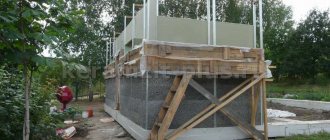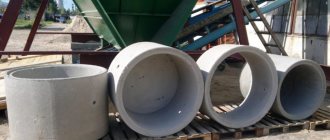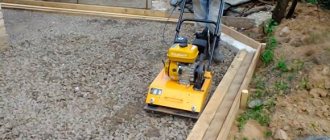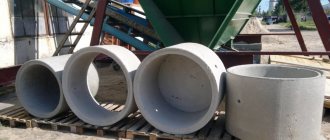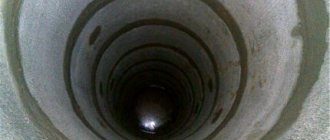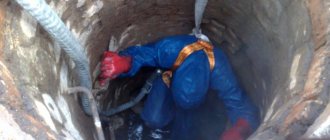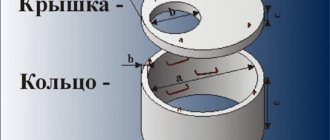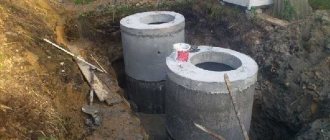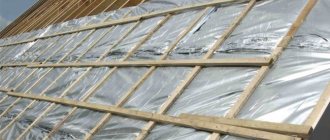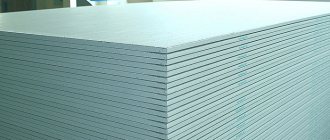Water is an important component of human life. It is used not only to satisfy the needs and comfort of the owner and his family members, but also for watering plants on the site, caring for animals and birds. In settlements where there is a centralized water supply, they do not think about its delivery.
It’s worse for those residents who are forced to bring or fetch water from somewhere else. In this case, it makes sense to dig a well on your site. The law allows you to have a well up to 20 m deep for your own needs without completing special documents.
How to choose a place
The location of the well is determined taking into account the requirements for its construction.
To prevent the entry of flood and surface water, it is better to dig it in a high place. You need to dig a well as far as possible from sources of possible pollution: cesspools and compost pits, barns for keeping pets, bathhouses, garbage dumps. Very often, the idea of digging a well on your property with your own hands begins with doubts: who to trust to find water. The hydrogeological exploration service will make 2-3 test drillings to accurately determine the occurrence of water and soil composition. This option requires significant costs.
Wells in neighboring areas
In most cases, private developers are guided by structures already existing in their neighbors or by folk signs. To dig a well in your dacha with your own hands, you should consult with your neighbors: what is the depth of their well, how does it supply water, what types of devices predominate. You cannot strictly rely on the position of your neighbors’ wells.
Soil layers have the property of uneven occurrence. Therefore, digging a well is strictly individual.
Plants
Plants around can serve as additional pointers to the right place. In the case when birch trees of different ages, heather, and reeds grow on the site, it is worth looking for water in these places. The branches of overgrown oaks, maples, and alders inclined in one direction indicate the close occurrence of a water layer. Lush thickets of nettles, coltsfoot, and ferns also indicate that the waters are close.
Observations of animals and nature
Animals and insects can help in finding the water vein. Ants build their heaps only in dry places: if there is an anthill, there will be no water. Dogs do not lie down in areas where water is nearby, but cats love its close position. When a dog or horse is thirsty, it tries to dig into the ground where there is a close supply of groundwater.
The nearby location of an aquifer is judged by a swarm of midges on a summer evening or by abundant fog in the morning. On winter days, thawed patches form in these places.
When the site is located on a drained swamp or low river bank, the water will not meet the requirements for domestic use.
Traditional methods
There are also ancient ways of finding aquifers.
One of the popular ones is dowsing. The frame is made from a flexible willow branch. Hold the ends with both hands and observe its deviations. When the frame is tilted down, the presence of water is judged. This method is carried out in the morning and on an empty stomach, since it is accurate only when a person has developed intuition.
There is an interesting way to search using chemical materials. Equal amounts of copper sulfate, sulfur and quicklime are thoroughly mixed, filled into canvas bags with the mixture and weighed. Dig in several places on the site. A day later, re-weighing is carried out. The bag with the greatest mass indicates the closest occurrence of water.
Recommendations for choosing a location for a well on a site:
Do-it-yourself well: how to dig it correctly
If there is no uninterrupted source of water at the dacha, not only everyday difficulties arise, but also difficulties with watering the plantings.
The problem can be solved by installing a well on the site, which will allow access to water of excellent quality in unlimited quantities. The optimal time to dig a well is summer and early autumn, when groundwater is low . Due to the low water level, the likelihood of making a mistake with the depth of the well is minimized.
Type and structure
Choose a well design. A developer deciding how to properly dig his well should familiarize himself with the main types. They are:
- key (ascending and descending);
- mine;
- pipe;
- drilling, or tubular.
The simplest and most cost-effective are key wells. They are placed in places where the source naturally comes to the surface. Water can come out of the ground under pressure or flow by gravity, so well construction varies slightly.
Well shaft type
If the water is at a level of 10–20 m, it is better to dig a shaft-type well. Such structures are divided into three types:
- Imperfect (incomplete). In it, the well is located above the waterproof layer; moisture accumulates there from the bottom, maybe through the side walls.
- Perfect (complete). The well rests on an impermeable horizon, and water enters through the side walls.
- Perfect with a grenade launcher. In this option, water is collected in the well gradually; for collection, an additional container is installed in the lower part - a grenade launcher. To function effectively, it must be deepened below the aquifer.
How to define an aquifer?
An aquifer is a layer of sand deep within the earth. If they come across it while digging, it means water will appear soon. Its height fluctuates, so you need to dig carefully so as not to deepen it. Otherwise, you will have to dig up to the next aquifer, the level of which is unpredictable.
Bottom filter in a well
A bottom filter is built at the bottom of the water intake; the quality of the liquid depends on it.
The thickness corresponds to the position of the water in the well. Practice has established that with a content height of 1.5 m, the filter should be 10–15 cm. The thicker its layer, the better the liquid is filtered. The bottom filter consists of three layers. The first is sand or small pebbles, the next is medium-sized gravel, the third is large stones. Each next layer is 5–6 times larger than the previous one.
If the well is dug on clay soil, then the construction of a bottom filter is not necessary. Clay itself is a good filter. When building on sandy soils, it is necessary to install a reverse bottom filter to prevent suspended sand particles from penetrating into the drinking water.
The process of installing a bottom filter in a well:
The optimal time to start digging a well
It is better to start building a well at a certain time. If you do this kind of work after spring floods, you may incorrectly determine the depth of the mine. During this period, the groundwater level rises significantly, and until it drops, you should not dig. Otherwise, it is often necessary to deepen the structure, since there will not be enough water in winter and summer.
The season when there is a lot of autumn rain is also considered unfavorable for starting construction. The best time to dig a well is summer heat or winter. During these periods, water runs out, and if you equip a working well, it will be guaranteed to supply the household with water throughout the year.
Construction in winter is complicated by freezing of the soil, but in early autumn or summer nothing will prevent you from starting excavation work. But there is only one exception, which is that when constructing a well on quicksand, it is advisable to dig it in winter.
Digging methods
You can dig a well without hiring outside workers, with your own hands. You just need to study the step-by-step instructions.
Typically, wells are constructed using concrete rings.
Before construction, it is determined by what digging methods the work will be carried out: by alternately installing the upper rings or by finding the level of the aquifer. The method is chosen based on the depth of the water.
Alternate installation of rings
The method of sequential installation of rings is as follows. The ring is placed on the surface of the earth and they begin to select the soil inside. Over time, it itself sinks into the depths. To dig a level well, it is necessary to ensure strict verticality, otherwise, if there is a strong slope, the concrete sediment will stop. You can adjust this yourself by tying a plumb line and setting a level on top of the ring.
After the top edge is level with the soil, a second one is installed on the ring. The next ones are installed as necessary until the lower one drops to the aquifer. You can immediately install gaskets to seal the seams.
This method allows you to control the height and number of rings and not be afraid of soil shedding, since the digger is inside.
When performing this option, it must be taken into account that it is inconvenient for one person to dig and remove soil. It will be necessary to involve one more employee. You will also need some extra help when installing the rings on top.
Installation of rings after reaching the aquifer
The second method is to initially excavate the well shaft and then install concrete once the aquifer is reached. This method is easier when digging, a person is not cramped inside the ring. It is possible to make deeper shafts. The rings are installed when the walls begin to crumble. Several rings are sealed against the ingress of flood and groundwater.
The disadvantages of this method are the following:
- It is possible to miss the beginning of soil collapse, then the mine will suffer.
- It is difficult to control the tightness of the structure; insulation is only possible from the outside.
- The amount of earth to be filled between the shaft and the ring is uncontrollable, as is its density. Therefore, flood and rainwater may enter.
How to dig a well yourself in practice:
Well construction technology
In a simplified way, the digging technology can be described as deepening a mine opening into the ground with the simultaneous construction of walls. The walls of the well can be wooden, representing an ordinary log house, cut into a paw. Concrete rings provide a technological alternative to a log house. The construction of a well from them is much simpler and much faster, but to install the rings you will need a lift. For a shallow source of water intake, a concrete pipe is suitable, which can simply be lowered into a pre-dug pit, or a plastic corrugated analogue.
Most often, wells are now built from concrete rings. However, there are still many fans of environmentally friendly wooden water intakes. Let's look at the most popular methods and find out how to properly dig a reliable well with durable walls that do not allow surface runoff to pass through.
Option #1 - wooden well
A wooden well frame is traditionally assembled from crowns, using standard methods of cutting log houses without residue, i.e. without angular bypasses extending beyond the outer outline. The part of the log house that is immersed in the ground and in contact with water is made from whole or split along alder, willow, and birch logs, because they do not affect, but even improve the quality of the produced water. Pine or oak timber is used to construct the above-water part because these types of wood can introduce a bitter taste. Oak is initially able to change the color of water, saturating it with tannins. But this fact can only be perceived as an initial obstacle to taking bath procedures.
To construct a log house, logs are taken with a diameter of 18 to 22 cm, the same size of plates chopped from logs is from 14 to 20 cm. It is difficult to calculate the number of crowns in advance, but you can “estimate” approximately. It depends on the depth of the planned excavation and the thickness of the material. The cracks between the rims of a well frame are not caulked, because the caulk quickly rots in water. But the underwater part of the log house does not deteriorate for 20 to 50 years, depending on the type of wood, because There is not enough oxygen under water for the development of putrefactive microorganisms. But the surface part, which is constantly in a moistened state, will need to be changed periodically during the long years of service of the wooden well.
Step-by-step instructions describing how to dig a wooden well for a bathhouse in a country house or on the territory of a personal plot:
- we chop into the paw and assemble on the surface a part of the well frame from 3-7 crowns, taking into account that the rather heavy structure will need to be moved and lowered into the pit;
- digging a pit approximately 1.5-2 m deep. The dimensions of the pit in plan should be slightly larger than the dimensions of the log house, so that there are no problems with its installation;
- We install the finished part of the well frame into the pit, and check its horizontalness by installing a construction spirit level on the upper crown. If there is no horizontal position, we adjust the position of the structure by digging up the ground from below in the required place with a sapper shovel;
- To lift the blade, we install a lifting tripod over the excavation. You can rent it or make it yourself from three logs, attaching a pulley block, gate or winch to the structure. The choice of lifting device must take into account that it will be necessary to lift not only the selected soil, but also the excavator;
- We select the soil from inside the log house, first in the center of the shaft, then under the central parts of the logs. The corners of the structure at this time rest on the unselected ground;
- We place pre-prepared supports-chocks under the walls, which should be equal in height;
- While we are going deeper, our assistant chops and adds another 1 or 2 crowns on top. The number of crowns to be built up is determined after the fact;
- We temporarily sew the frame together on the outside with a board, fasten the corners with staples or nailing down timber so that there are no distortions when lowering. We hammer nails into each crown;
- Having dug the corners, we remove the supports so that the frame settles spontaneously;
- We stimulate the “tight motion” of the log house in the body of the shaft by hitting the upper crown with a sledgehammer, having first placed cuttings of boards on its logs. If the structure rests against dense rock or “sits” at an angle on a boulder, we build up the crowns from below. We undermine the ground to the thickness of one log and sequentially install the elements of the crowns;
- We repeat all the steps, following the given algorithm: well frame to the aquifer. Digging a well most often stops in the sand. If the thickness, or thickness, of the aquifer is more than 3 meters, the base of the well should not rest against the underlying water-resistant layer so that water can freely penetrate into the water intake;
- We pump out the water that appears in the well and continue to work on the front of increasing depth, without reaching the lower aquitard - clay, loam, rock;
- We level the bottom of the well shaft and form a simple bottom filter by filling it with coarse sand, then gravel, and crushed stone or pebbles on top. The total backfill thickness is 40-50cm. The bottom filter will prevent the water from becoming turbid;
It is impossible to predict in advance the flow rate and thickness of a water-saturated reservoir. If water flows in abundance, then the technology for constructing a wooden well will have to be changed somewhat. The well frame is then strengthened with collaterals - logs, the length of which is at least 50 cm longer than that of ordinary logs. Because The logs are longer than ordinary logs; stoves need to be dug in the walls of the shaft - depressions in the ground for their installation. You will need to go deeper using a box made of thick boards on the surface of the earth. The soil from the mine is removed until the work can be carried out.
According to the requirements of the above-mentioned SNiP, the above-ground part of the well should rise 80 cm above the ground. A clay castle is installed around the excavation, which will prevent surface runoff and atmospheric water from penetrating into the well. The depth of the castle, created from compacted clay or loam, is 1.5 m, width 0.5 -1.0 m.
Option #2 - a well made of concrete rings
There are no fundamental differences in the methods of constructing a wooden and concrete well. Construction is carried out in a similar lowering manner with a gradual build-up. The difference is that there is no need to cut down the log house. The work will go significantly faster and more fun. You just need to purchase the rings in advance, preferably with a tongue-and-groove type lock on the end circles. The diameter of suitable concrete rings ranges from 1m to 1.5m. The amount depends on the depth of the water intake. The lower water intake ring must have a factory filter in the wall.
A brief step-by-step instruction for those who decided to arrange a water supply for a bathhouse with water supplied from a concrete well:
- we dig a mine without going deeper than 3m;
- We install 2-3 rings at the bottom of the excavation, the first of which should have a filter. It is strongly recommended to treat the outer side of the concrete well shaft with a sealing compound;
- For reliability, we connect the rings together with staples, bolts or pins. True, fastening rings is used mainly in cases where rings without a locking chamfer were purchased for construction. However, for your own peace of mind, you can strengthen it;
- under the base of the lower ring we dig out 4 recesses into which we place bricks or lumps;
- We dig in the space under the ring and lift the blade up. The concrete “pyramid” at this time rests on chocks;
- we remove the supports so that the well trunk settles on its own;
- We continue to go deeper in the same sequence and build up rings from above;
- Finally, a filter is placed at the bottom, and a clay castle is placed around the ground part.
The described method is acceptable for the construction of shallow water intake up to 6 m. There is a seamless technology for constructing a deeper concrete well. To do this, a shoe with a cutting edge is installed on the leveled bottom of the pit, and formwork is then mounted on it for pouring the concrete mixture. Do not forget that poisonous gas can accumulate in the well shaft! Check the air in the mine with a gas analyzer every day before work. Do not work alone, wear a safety harness and a hard hat.
Commissioning
Once the new well is dug by hand, a clay lock is installed to prevent the penetration of surface water. It is very good to equip a concrete blind area. The first water from the well is pumped out repeatedly until the water flows clear.
Waterproofing
Waterproofing the well is an important final stage. If the well was built with the initial excavation of the earth, it is easier to complete. The easiest thing is to coat it with bitumen mastic up to the middle of the second ring.
When building a well by immersing rings, you will have to dig out the soil and only then coat it with the composition.
Well waterproofing process:
Cleaning walls and internal sealing of seams
Wall cleaning work is carried out as follows:
- The water is pumped out several times.
- They go down into the well and clean the rings from dirt and mucus using a metal brush or other device; disinfect the well.
After the initial cleaning, the seams should be treated to seal. To do this, use a mixture of sand and cement in a ratio of 1:3. Some of the water can be replaced with PVA glue or liquid glass.
Safety at work
All work on the construction and operation of wells is carried out with mandatory compliance with safety regulations. It assumes:
- Fence off the area where digging will take place.
- Remove foreign objects 2-3 m around the hole so that they cannot get there.
- Every day before starting work, check the reliability of the ropes and buckets with which the earth will be removed to the surface.
- Securely attach the cable to the container.
- Make sure there are no harmful gases in the mine.
- You cannot go into a well without a protective helmet on your head, or work without an assistant who is on the surface and monitors the worker in case of unforeseen situations.
- If you feel even a slight deterioration in your health, you should leave the mine.
( 1 ratings, average: 5.00 out of 5)
Previous entry Selecting equipment for a well with a caisson
Next entry The arrangement and principle of operation of the Abyssinian well

